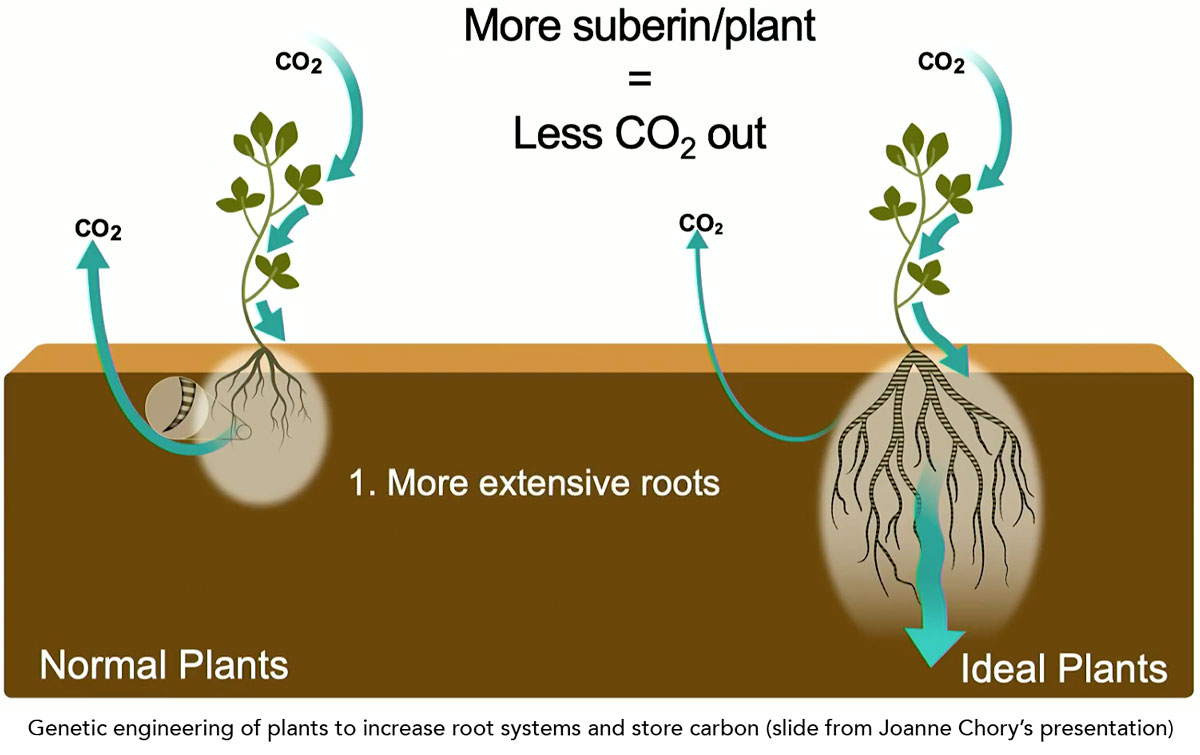
Zen Honeycutt explains why plans to grow GM carbon-sequestering plants are a dangerous distraction
 On March 22, 2021, The Del Mar Garden Club of Southern California held an informational session called “Fighting climate change with plants”. As a person who is extremely concerned about the looming apocalyptic events due to climate chaos, but not extremely well informed about what we can do to prevent them, I signed up.
On March 22, 2021, The Del Mar Garden Club of Southern California held an informational session called “Fighting climate change with plants”. As a person who is extremely concerned about the looming apocalyptic events due to climate chaos, but not extremely well informed about what we can do to prevent them, I signed up.
I quickly realised that the presentation was not going in the direction that I had hoped, meaning extolling the innate virtues of plants that have the ability to sequester carbon if we just let Mother Nature do her job. No. Featured speaker Joanne Chory, a plant geneticist from the Salk Institute, based in San Diego, CA, shared how she and her team were genetically engineering plants to have bigger roots, longer roots, and roots that sequester more carbon by manipulating the gene that makes suberin, a molecule that functions within plants as a physical barrier and hardens plant cells, to make more suberin and therefore hold more carbon, and then put those genes into crop plants. They were going to start with sorghum. (I will talk about why that is interesting later.) She showed slides depicting what would be manipulated and how the roots were in fact growing longer in preliminary trials. I actually considered that it might be a good idea. For about a second.

Then I remembered, and she confirmed, that the goal was to get these seeds into the hands of every farmer in America. That means to sell for a profit, with a technology premium. She claimed that the genetic engineering that she just said was genetic engineering was not considered by the FDA to give rise to a genetically modified organism (GMO). (Chory is incorrect – see below[1].) According to her, this is because other species (like fish DNA) were not being introduced into the test subject plants (like GMO tomatoes). In these plants, their own genes were being manipulated. She wrongly implied that this type of genetic engineering is considered by our FDA to give rise to a hybrid. She confirmed that the seeds would need to be repurchased by farmers (instead of saving them for free) every year, except for rice.[2]
The goal
 Chory was very clear that the goal was to get the seeds planted on 500 million hectares, which is 1.2 billion acres. To put this in context, we currently only have 896 million acres of farmland in America. My blood began to boil as I realised their goal was to take over all agriculture and push GMO seeds even on organic and biodynamic farmland. I am not asserting that their intention is to maliciously wipe out organic farmland. She made it very clear that their intention was to draw down 4-8 gigatons of carbon per year and play a major role in reversing climate change and saving the planet. The end result, however, which should not be ignored, would be that all of the acres that are currently being farmed as organic or biodynamic would need to be converted to GMO farming in order for them to meet their goals. And you can be sure anyone interested in funding their work, whether it be a San Diego philanthropist or the government, would be invested in the Salk meeting their goals.
Chory was very clear that the goal was to get the seeds planted on 500 million hectares, which is 1.2 billion acres. To put this in context, we currently only have 896 million acres of farmland in America. My blood began to boil as I realised their goal was to take over all agriculture and push GMO seeds even on organic and biodynamic farmland. I am not asserting that their intention is to maliciously wipe out organic farmland. She made it very clear that their intention was to draw down 4-8 gigatons of carbon per year and play a major role in reversing climate change and saving the planet. The end result, however, which should not be ignored, would be that all of the acres that are currently being farmed as organic or biodynamic would need to be converted to GMO farming in order for them to meet their goals. And you can be sure anyone interested in funding their work, whether it be a San Diego philanthropist or the government, would be invested in the Salk meeting their goals.
Chory mentioned that they had an advantage, however, with the technology, because the ag industry has farm subsidies (i.e. taxpayer dollars) and farmers would be supported to plant these crops. My question is: will they NOT be supported if they don’t? In addition, Chory pointed out that the Carbon Bank was projected to be in place by 2030 and corporations would be able to pay farmers for sequestering the carbon that those corporations produce. So instead of being innovative and creating methods to reduce carbon emissions, or using technology that runs on renewable, clean energy, corporations can go on their merry way utilising fossil fuels and just pay someone else to clean up their mess. Hmmm...
The Salk Institute scientist showed how they currently have four test sites in America and plan to have 20 by the end of the year, to test the suberin enhanced, carbon-absorbing plants in different types of soils. They also needed to confirm that the plants did in fact sequester more carbon.
She said, “We are on an aggressive timeline to meet the climate crisis change,” leaving out the fact that GMO scientists and farmers helped create the climate crisis by monocropping, factory farming, and the wholesale destruction of our topsoil.
Questions
Then the question and answer period started and a person asked, “Are there any native plants that already do this?”
Chory answered, “I don’t know.” She had not researched native plants. I was shocked. Surely, before you invest any time or energy into making anything, you should do your research and see if that product already exists?
Someone asked her if she gardened, as it was a gardening club after all, and she responded, “You know my daughter likes to say that I know a plant better on the inside than the out. So if you put a canola plant in front of me I probably wouldn’t know.”
Excuse me? A person who wants every farmer in America to buy her company’s products cannot identify a canola plant? My mother taught me to see the good in everyone but my brain was telling me that this was just not good on any level.
Expert review of Salk Institute Initiative
To confirm or dispel my suspicions I turned to an expert, one of our Moms Across America advisors, Dr Don Huber, a 60+ year plant pathologist and Professor Emeritus at Purdue University, a verified expert on plants and soil. He pointed out the following issues with the Salk project, in summary, below.
* If they wanted the suberin to sequester more carbon they would have to stop spraying all glyphosate. Glyphosate disrupts the shikimate pathway and suberin is formed in the shikimate pathway. Glyphosate, and some other herbicides, are strong mineral chelators that immobilize iron (Fe), a critical co-factor for peroxidases and other enzymes so suberin and lignin production in the roots can be stopped because adequate Fe is not available for it to be formed.
* Focusing on the gene that produces suberin in the roots is myopic. That means only focusing on one aspect, not the whole. Suberin is produced through secondary metabolism. Photosynthesis is the best way to sequester carbon, and that requires every cell of the whole plant.
* If they truly want to increase carbon sequestration they should look at how to make all plants healthier for more efficient photosynthesis. The best way to make the plants healthier is to stop using glyphosate and other agrochemicals because they damage the necessary physiological pathways of the plant and therefore reduce its ability to sequester carbon.
* Getting rid of glyphosate use in agriculture would accomplish many things that improve the health of plants including increase nutrient density of the plant, increase disease resistance, increase carbon sequestration and increase yield. The organic regeneratively tended soil would also increase in organic matter and absorb tons of carbon per acre separately from the plant. The increased organic matter in the soil will absorb more water, reduce drought and erosion, and minimize the potential dust-bowl effects of climate change.
* Diverting energy to make the roots larger through suberization would compromise nutrient density and yield of the rest of the plant. Root growth is dependent on critical micronutrients such as manganese (Mn), calcium (Ca), and boron (B), whose availabilities are disrupted by various agricultural and environmental factors that are already often in short supply for primary growth.
* Using the sorghum plant is an interesting trial choice because it is already one of the leading plants that sequester carbon. Claiming that it was only the genetic manipulation that led to the carbon sequestration will be something to look out for. Comparative studies will need to be done, not only with the same species of plants but with other native plants, perennial grasses, maize (corn), and sugar cane (a high carbon-absorbing plant), or other C4 (highly photosynthetically efficient) plants as well.
* Focusing on sequestering only carbon does not fix the problem. Nitrous oxide is just as much of the climate problem (heat being retained in our atmosphere) and it can be addressed through nitrogen-fixing plants like legumes, or nitrification inhibiting plants (climax ecosystem species), which can be used in regenerative organic farming as cover crops.
* Focusing on the roots also means creating a landfill, so to speak, of carbon. We don’t want a dump of carbon. We want the carbon working for us to produce an abundance of nutrient-dense, safe food at an affordable price. We can do that by maintaining the health (eliminating toxic agrochemicals) and growth of the plant through photosynthesis.
Here’s the problem (for them). The Salk Institute, Bayer, Dow/Dupont, or other major conglomerates cannot patent photosynthesis (yet, anyway) and make money off of it. Mother Nature created that a long time ago. The idea to genetically engineer the gene that produces suberin, while an interesting concept that may be successful in terms of its own singular intended outcome in a lab setting, is overall an inefficient plan for reversing climate change. There are plants existing now, and methods that exist now, for sequestering carbon and we don’t have to wait another 15-20 years for the trials and rollout of planting 1.2 billion acres with these GMO plants to obtain 4-8 gigatons of carbon sequestration per year.
Funding
One more issue that must be acknowledged is the funding. This project will take dozens of brilliant scientists 10 years of development at Salk and then hundreds more people for marketing and sales. Hundreds of thousands or millions of farmers and their resources will be needed to implement the project and absorb the carbon for another 10 years. Those resources need to be spent on other issues that are far more efficient and necessary.
Instead of spending countless hundreds of millions, much of it likely taxpayer dollars, on genetically engineered plants, why not direct that funding to farmers to transition to regenerative organic, and start sequestering carbon right now? Or how about providing homes for our homeless, evicted by Covid repercussions or severe weather, innovation education for our children, school lunches that won’t make them sick, or giving care to veterans and elderly that leaves them with at least an iota of dignity? Why not put the money somewhere that will take care of thousands or millions of underserved people right now instead of to a few dozen scientists in a lab in Southern California? It simply is an injustice to spend money on a “pipe dream”, as Dr Huber classified it, rather than the harsh reality millions are facing right now and the available solutions, like regenerative organic agriculture.
The real solution
According to Regeneration International: "Just transitioning 10 percent of agricultural production to best practice regenerative (organic) systems will sequester enough CO2 to reverse climate change and restore the global climate.
"Ten percent of agricultural lands under BEAM (Biologically Enhanced Agricultural Management – a process developed by Dr David Johnson of New Mexico State University, that uses compost with a high diversity of soil microorganisms) would sequester 18.4 gross tonnages (GT) of CO2/yr. Ten percent of grasslands under regenerative grazing would sequester 9.8 Gt of CO2/yr. This would result in 28.2 Gt of CO2/yr being sequestered into the soil which is just under double the amount of sequestration needed to draw out more CO2 than is currently being emitted."
This plan is not a pipe dream: it is doable. Farmers are transitioning to regenerative organic agriculture right now. Consumers are seeing the benefits, and they want food that is not only good for their families but good for the soil and planet as well. We already have the solution, and it is biodiverse, beautiful, healthy, and rewarding. It is regenerative organic agriculture.
Moms Across America requests that the Salk Institute reinvest their funding for this suberin genetic engineering into supporting farmers transition to organic. We request that philanthropists and the government also invest in nonprofits and groups who are supporting the transition to organic such as Rodale Institute, Savory Institute, Regeneration International, Farmer’s Footprint, and Kiss the Ground; and consumer organisations that are educating the public about the benefits of these foods (because after all, someone needs to buy the food), such as the Organic Consumers Association, Friends of the Earth, Green America, and Moms Across America.
This article is an excerpt from a book in progress. To submit for consideration innovative plans and inventions that solve current climate, pollution, and corruption problems, email This email address is being protected from spambots. You need JavaScript enabled to view it..
A previous version of this article was published on the Moms Across America website: https://www.momsacrossamerica.com/fighting_climate_change_with_plants
Notes
1. According to the FDA definition, these plants are genetically engineered. See "Voluntary Labeling Indicating Whether Foods Have or Have Not Been Derived From Genetically Engineered Plants". Particularly, see the second paragraph where the FDA says "we use the terms “genetic engineering” and “bioengineering” to describe the use of modern biotechnology. Modern biotechnology means the application of in vitro nucleic acid techniques, including recombinant deoxyribonucleic acid (DNA) and direct injection of nucleic acid into cells or organelles, or fusion of cells beyond the taxonomic family, that overcome natural physiological reproductive or recombinant barriers and that are not techniques used in traditional breeding and selection of plants (Ref. 1). The term “modern biotechnology” may alternatively be described as “recombinant DNA (rDNA) technology” (Ref. 2), “genetic engineering” (Ref. 3), or “bioengineering.” These terms are often used interchangeably by industry, federal agencies, international bodies, and other interested stakeholders and are used in this guidance to refer to foods derived from new plant varieties developed using modern biotechnology. The term “genetic modification” is also sometimes used to refer to the use of modern biotechnology (e.g., Ref. 4), although FDA’s longstanding position, as discussed later in this guidance, is that such use of the term is less accurate because the term encompasses the broad spectrum of genetic alterations that can be made in plants (see, e.g., Ref. 5)"
Also note that FDA has been on record as being against using the term "genetic modification" since they consider that more broadly. In a sense, any form of breeding does modify the genetics of an organism; that's why the use of this term is very confusing, especially to academic scientists in the US. In the EU, genetic modification has a very strict legal meaning that was first laid out decades ago when they put their first regulations in place on the release of genetically modified organisms.
2. Reasons for this exception were not explained.
Comment by GMWatch: Scientists have long known that deep-rooted plants sequester more carbon, as well as retaining more water and nutrients. Permaculture is a regenerative farming system that has always recognised the importance of favouring deep-rooted perennial crop plants over the shallow-rooted annual ones that currently take up so much of our farming systems. Clearly the most effective way to increase carbon storage in root systems, as well as conserving water and nutrients, is to promote a system-wide shift to permaculture principles.
Image: Sorghum in Mozambique 2, by Swathi Sridharan, via Flickr. Reproduced under Attribution-ShareAlike 2.0 Generic (CC BY-SA 2.0) licence.










